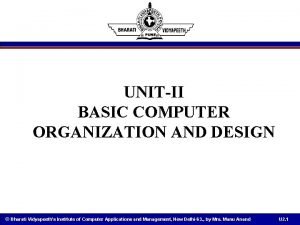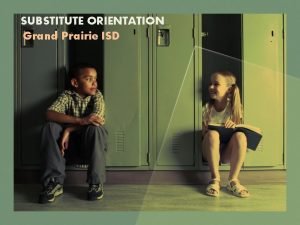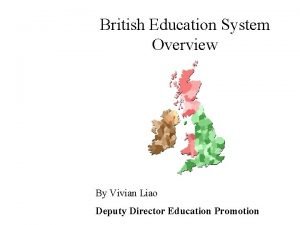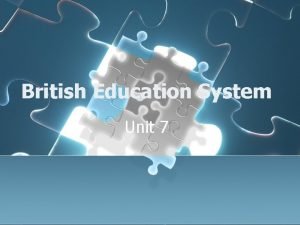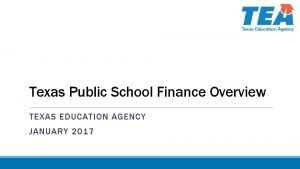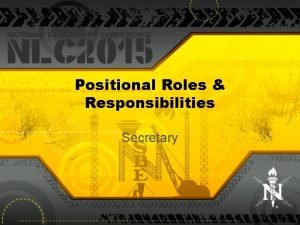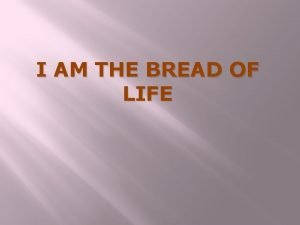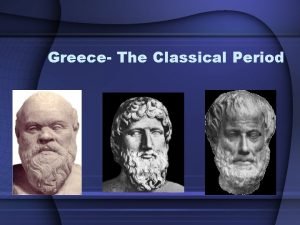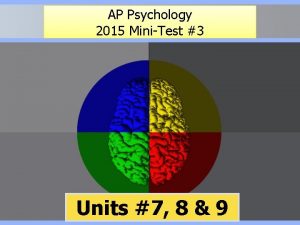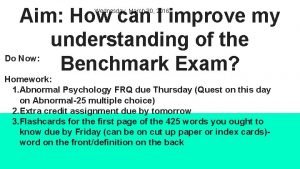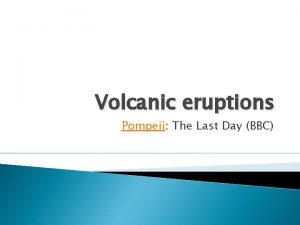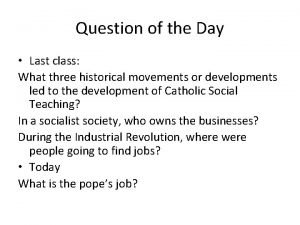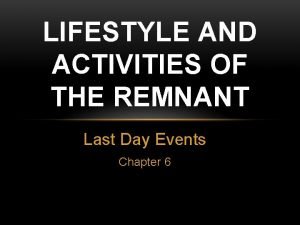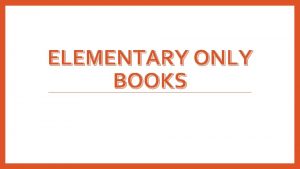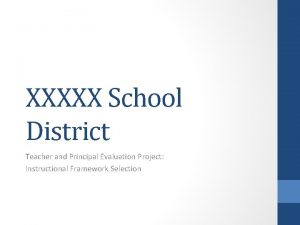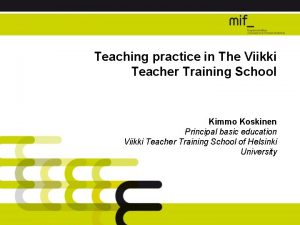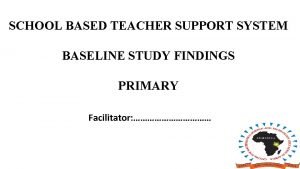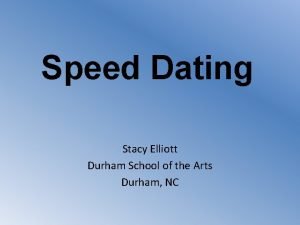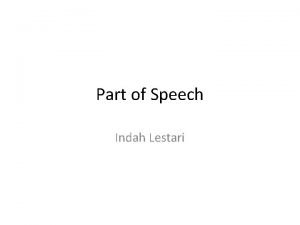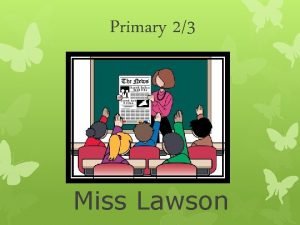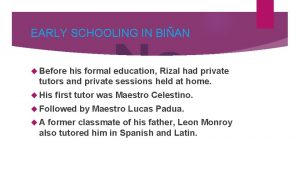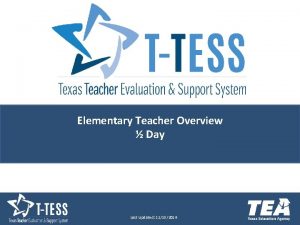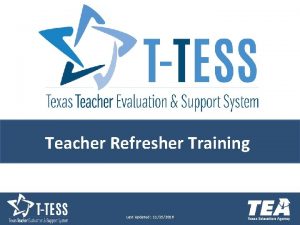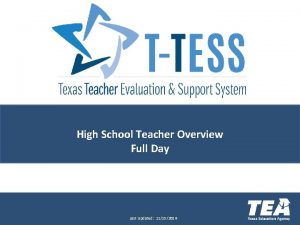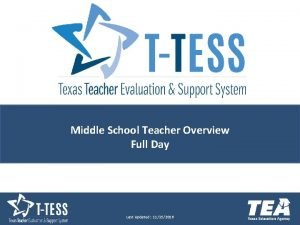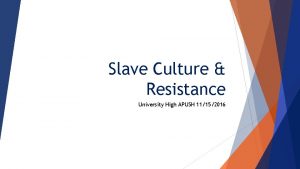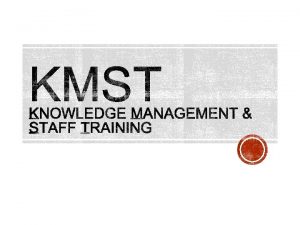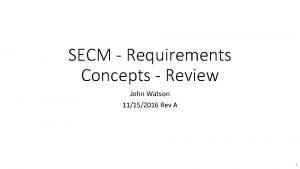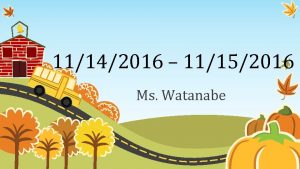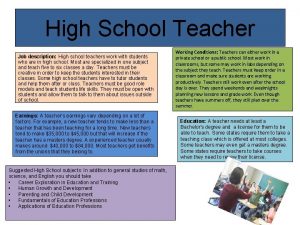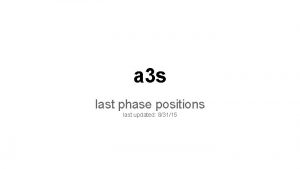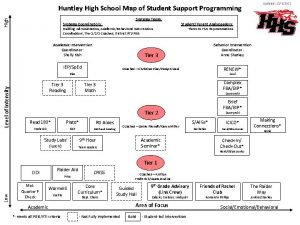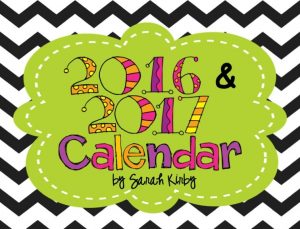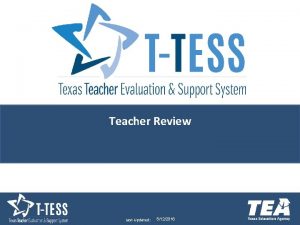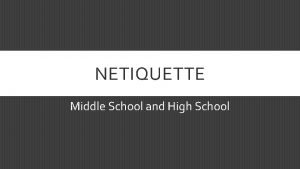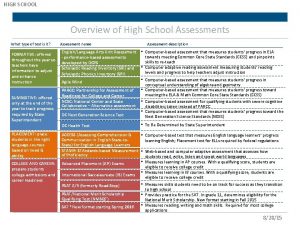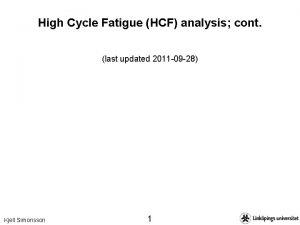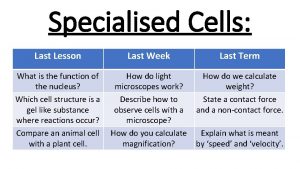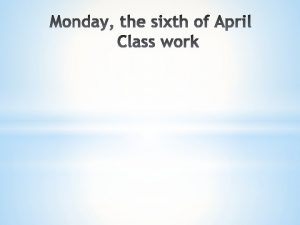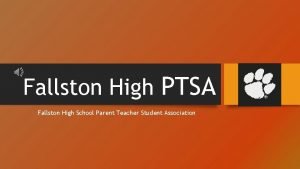High School Teacher Overview Day Last Updated 11152016













































- Slides: 45

High School Teacher Overview ½ Day Last Updated: 11/15/2016

Objectives: The teachers will: • become familiar with the T-TESS process; • begin to move from procedural to conceptual in understanding how the domains, dimensions, descriptors, and performance levels of the T-TESS rubric apply to their roles and responsibilities; and • understand that the T-TESS process is based on best practices and an ongoing system of feedback and support. 2

Introductory Video 3

It’s a Process, not an Event. • Overview and Introduction • Public Learners • T-TESS Experts 4

Texas Teacher Standards New! • 149. 1001 – Purpose: The standards identified in this section are performance standards to be used to inform the training, appraisal, and professional development of teachers. • Six (6) Standards • Standard 1: Instructional Planning and Delivery • Standard 2: Knowledge of Students and Student Learning • Standard 3: Content Knowledge and Expertise • Standard 4: Learning Environment • Standard 5: Data-Driven Practice • Standard 6: Professional Practices and Responsibilities Texas Administrative Code, Chapter 149. – Effective June 8, 2014. 5

Requirements – Full Appraisal Requirements One observation 45 minute minimum (can be conducted in shorter increments based on context) No requirements for announced versus unannounced Post conference within 10 business days Pre-conference is optional in year one, required year two and beyond Goal-setting and professional development plan* End-of-year conference as final collaborative meeting* *Also required for teachers not undergoing full appraisal 6

The Rubric Created by a steering committee comprised of Texas Educators based on best practices, requirements with the new Texas Teacher Standards, and research… 7

Elements of an Effective Lesson Placemat Consensus Elements What are your favorite hobbies? 8

Elements of an Effective Lesson Placemat Consensus Person A: Basketball Soccer Gardening Reading Scrapbooking Basketball Gardening Reading Person D: Woodworking Basketball Reading Gardening Collecting Cards Person B: Gardening Camping Basketball Soccer Reading Person C: Coin collecting Interior Designing Basketball Gardening Reading What are your favorite hobbies? 9

Placemat 10 Minutes Total! Placemat. Consensus –– 10 Total! 2 minutes to write individually 3 minutes to talk and reach consensus 5 minutes to debrief Participant A Participant B Consensus Elements Participant D Participant C As you reflect upon a recent lesson you observed or delivered that was effective, what occurred during that lesson that led it to be effective? 10

Effective Elements Summary • Rigorous and measureable goals aligned to state content standards • Student engagement and interaction • Alignment of activities and materials throughout lesson • Student relevancy • Teacher displays content knowledge • Numerous checks for mastery • Teacher asks probing questions to extend learning • Evidence of student mastery of the objective • Differentiation 11

T-TESS Rubric Overview Planning • • Standards and Alignment Data and Assessment Knowledge of Students Activities Professional Practices and Responsibilities Learning Environment Instruction • • • Achieving Expectations Content Knowledge and Expertise Communication Differentiation Monitor and Adjust • • • Classroom Environment, Routines, and Procedures • Managing Student Behavior • Classroom Culture Professional Demeanor and Ethics Goal Setting Professional Development School Community Involvement 12

T-TESS Rubric Handout 13

T-TESS Rubric Domain 14

T-TESS Rubric 15

T-TESS Rubric Dimension 16

T-TESS Rubric 17

T-TESS Rubric Descriptors 18

T-TESS Rubric 19

T-TESS Rubric Performance Levels 20

T-TESS Rubric Overview Planning • • Standards and Alignment Data and Assessment Knowledge of Students Activities Professional Practices and Responsibilities Learning Environment Instruction • • • Achieving Expectations Content Knowledge and Expertise Communication Differentiation Monitor and Adjust • • • Classroom Environment, Routines, and Procedures • Managing Student Behavior • Classroom Culture Professional Demeanor and Ethics Goal Setting Professional Development School Community Involvement 21

Evaluation Focus Learner Outcomes Teacher Behaviors B, M, E Student Behaviors 22

What is the Process of Modeling Your Thinking (Think-Aloud)? I do Think Aloud We do Scaffold & Cue You do Students Explain Thinking 23

Communication (Instruction Dimension 2. 3) Handout 24

Rubric Activity Handout Directions: • Trainer just modeled metacognition for Communication. • Each group will use the same process to deconstruct the rubric for the following dimensions: • Standards and Alignment (1. 1) • Content Knowledge and Expertise (2. 2) • Classroom Environment, Routines and Procedures (3. 2) • You will have 5 minutes per dimension. 25

Collective Evidence is Essential • Detailed Collection of Evidence: Unbiased notes of what occurs during a classroom lesson. • Capture: • what the teacher says • what the teacher does • what the students say • what the students do • Copy wording from visuals used during the lesson. • Record time segments of lesson. The collection of detailed evidence is ESSENTIAL for the observation process to be implemented accurately, fairly, and for the intended purpose of the process. 26

When Do You Collect Evidence Prior to the Lesson Being Observed • Pre-conference • Review of lesson and/or unit plans as applicable During the Lesson • What the teacher says and does • What the students say and do After the Lesson • Communication between classroom observation and postconference 27

Evaluation Cycle Announced Pre. Conference Observation Unannounced Observatio n Post. Conference 28

10 Minute Break 10: 00 29

T-TESS: Evidence-Based Process What do you view as the purpose for a pre-conference? 3: 00 What are the benefits for you, the teacher? 30

Purpose of the Pre-Conferences • To provide the teacher with an opportunity to share his/her thought process in developing the lesson/plan and provide additional details about the upcoming observation. • To clarify expectations for teacher and student performance. • To provide the appraiser with information about the lesson observation and criteria that may not be directly observable. 31

View a Lesson • We will now watch a lesson. • Assume you are the appraiser. • What is your task as an appraiser during the lesson? 32

Scripting the Lesson Reminders What does the teacher say? What does the teacher do? What do the students say? What do the students do? - Copy wording from visuals used during the lesson. - Record time segments of lesson. 33

View High School English Honors Lesson Video 34

Observation of Classroom Instruction • Reflect on the lesson you just viewed and the evidence you collected. • Based on the evidence, do you view this teacher’s instruction ‘Proficient’, ‘Above proficient’, or ‘Below proficient’ ? • A thumbs up is above proficient, a thumbs down is below proficient, and in the middle is proficient. 35

Categorizing Evidence (We do) Using the template provided, we will categorize evidence for: • Achieving Expectations (2. 1) • Content Knowledge and Expertise (2. 2) • Differentiation (2. 4) • Monitor and Adjust (2. 5) • Classroom Environment, Routines and Procedures (3. 2) • First, categorize your evidence as a table group. • Then, based on the evidence and the rubric, assign ratings to the dimension. • You will have 10 minutes to complete the activity. 36

Whole Group Debrief • We will debrief the evidence as a whole group. 37

Post-Conference Round Table As a classroom teacher, what do you want from a post-conference? Using your talking chips/clips, each participant will share two things a classroom teacher should want from a post conference 38

Post-Conference Round Table As a classroom teacher, what do you NOT want from a post-conference? Using your talking chips/clips, each participant will share two things a classroom teacher should not want from a post conference. 39

Four Key Elements of the Instruction Post-Conference Introduction Reinforcement Refinement Greeting Reinforcement Area (Dimension) Refinement Area (Dimension) Review Conference Process Self-Analysis and Follow-Up Questions Ask a general impression question about the lesson. Share Evidence for Reinforcement Share Evidence for Refinement Review Ratings Share Evidence for Ratings Share Recommendations 40

Objectives: The teachers will: • become familiar with the T-TESS process; • begin to move from procedural to conceptual in understanding how the domains, dimensions, descriptors, and performance levels of the T-TESS rubric apply to their roles and responsibilities; and • understand that the T-TESS process is based on best practices and an ongoing system of feedback and support. 41

T-TESS Thoughts… ü "Great teaching is at the core of every quality education system. “ ü "Research shows that there is no greater in-school factor than having an outstanding education in the classroom. “ ü T-TESS was developed by educators for educators. ü T-TESS is aligned to research-based, best practices for teaching and learning. ü The T-TESS Rubric aligns directly with the new Texas Teacher Standards. ü The T-TESS process provides for actionable, timely feedback, allowing teachers set goals and identify professional development that will lead to refinement in knowledge and skills. 42

T-TESS Thoughts… ü The 'Proficient' performance level is representative of a 'Rock Solid' teacher. ü There will be some necessary culture shifts to establish a new mind set for the relationship with appraisals and supporting teachers. ü Everyone in the school community is a public learner. ü The ultimate outcome is improved student achievement. 43

Here’s What…So What…Now What… Here’s What… (T-TESS Key Points) So What… Now What… (So, what are your “takeaway” points? ) (Now, what do you need? ) 44

Thanks for Your Participation! For more resources please visit our website: Teachfor. Texas. org 45
 Day 1 day 2 day 3 day 4
Day 1 day 2 day 3 day 4 During _______ branching, only car is updated with adr
During _______ branching, only car is updated with adr Performance monitoring and coaching form sample
Performance monitoring and coaching form sample Day 1 day 2 day 817
Day 1 day 2 day 817 South grand prairie high school substitute teacher
South grand prairie high school substitute teacher Erf form for teachers deped
Erf form for teachers deped Hello teacher good afternoon
Hello teacher good afternoon The person who phoned me last night is my teacher
The person who phoned me last night is my teacher Crescenta valley high school graduation 2021
Crescenta valley high school graduation 2021 Haltom high school summer school
Haltom high school summer school Texas recapture districts
Texas recapture districts British school system overview
British school system overview British school system overview
British school system overview Texas public school finance overview
Texas public school finance overview Last day email
Last day email Chipstenoso
Chipstenoso Last day of socrates
Last day of socrates Doing goal setting on the last day before gspeed freezes
Doing goal setting on the last day before gspeed freezes According to jean piaget children cease to exhibit
According to jean piaget children cease to exhibit Elizabeth picks up the clothes from her bedroom floor
Elizabeth picks up the clothes from her bedroom floor Pompeii tectonic plates
Pompeii tectonic plates Primary school leavers poems
Primary school leavers poems Last class of the day
Last class of the day Last day events chapter 6
Last day events chapter 6 Ms bixby's last day summary
Ms bixby's last day summary William beanes elementary
William beanes elementary Oceans apart day after day
Oceans apart day after day Day to day maintenance
Day to day maintenance Physical science chapter 6 review answers
Physical science chapter 6 review answers I don't know about tomorrow
I don't know about tomorrow Romeo and juliet timeline sunday through thursday
Romeo and juliet timeline sunday through thursday Growing day by day
Growing day by day Define seed dormancy
Define seed dormancy Conclusion of seeds
Conclusion of seeds Geotropism
Geotropism I live for jesus day after day
I live for jesus day after day Casting crowns glorious day (living he loved me)
Casting crowns glorious day (living he loved me) Day one day one noodle ss2
Day one day one noodle ss2 Dayone dayone noodles ss2 小時光 肆號麵鋪
Dayone dayone noodles ss2 小時光 肆號麵鋪 Xxxxx teacher
Xxxxx teacher Viikki teacher training school
Viikki teacher training school School based teacher support system
School based teacher support system Mrs elliott a teacher at durham school of the arts
Mrs elliott a teacher at durham school of the arts (dita) is an amazing english teacher at school
(dita) is an amazing english teacher at school Ms lawson a primary school teacher
Ms lawson a primary school teacher Rizal started his formal schooling in
Rizal started his formal schooling in

